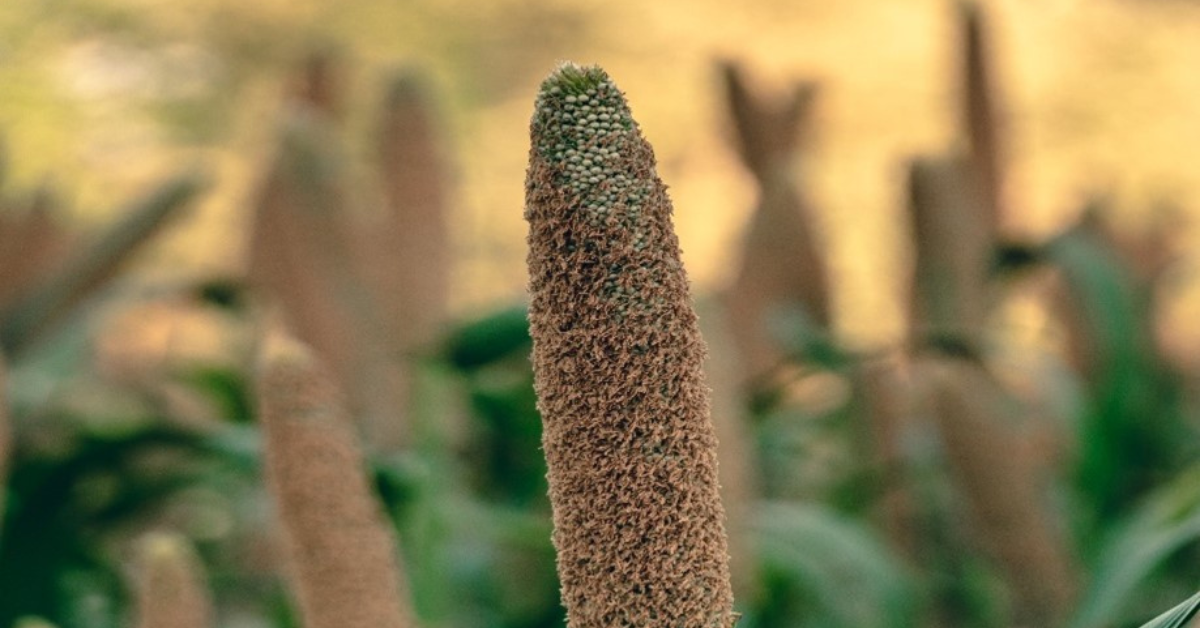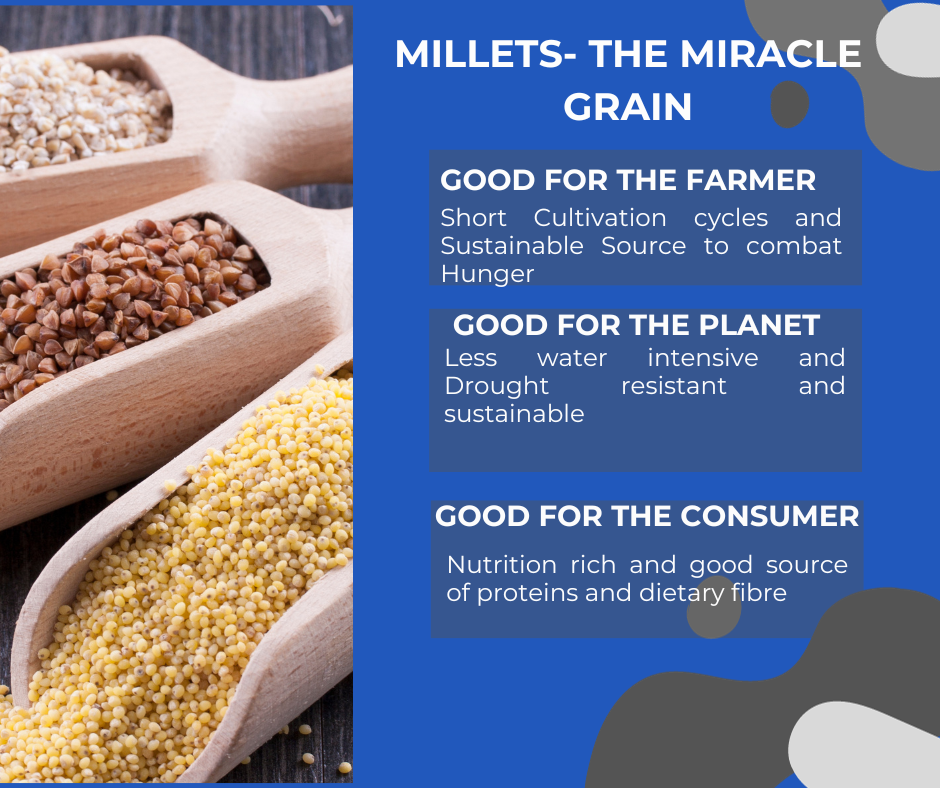Contact: +91 99725 24322 |
Menu
Menu
Quick summary: Discover how growing millets can lead to a sustainable future, supporting eco-friendly farming practices, boosting resilience to climate change, and promoting food security.

Millets for a sustainable future- yes, a crop that thrives in dry soil, demands minimal water, and enriches the land it grows on – all while packing a powerful nutritional punch. Millet, a resilient grain that has been feeding communities for centuries yet remains overlooked in today’s dominant agricultural systems.
Millets are drought resistant, requiring a very low amount of water; approximately 200-300 litres of water is required to produce 1 kg of millet
As climate change accelerates, threatening food security and depleting vital resources, farmers and consumers alike are searching for sustainable, resilient alternatives to traditional crops. But here’s the challenge: most staple grains are resource-intensive and struggle to adapt to harsher, more unpredictable climates.
Millets, however, offer a promising solution. Not only can they withstand extreme weather conditions, but they also require fewer inputs, making them an ideal choice for sustainable farming. So, how can millet cultivation transform our food systems and bring us closer to a sustainable future?
Key Takeaways
Millets are a group of small-seeded grasses cultivated for human consumption. Nutrient-rich and resilient, they include varieties like sorghum and pearl millet. These grains are gluten-free, environmentally sustainable, and contribute to food security, making them crucial for diverse, nutritious diets worldwide.
Millets hold historical significance as ancient grains cultivated across various civilizations. Their cultural importance is reflected in traditional cuisines, rituals, and folklore. Adaptability to diverse climates contributed to their global presence, sustaining communities and shaping culinary heritage, showcasing the rich interplay between agriculture, culture, and history.
Millets are gaining recognition in modern diets due to their nutritional density, gluten-free nature, and environmental sustainability. As awareness of health and ecological concerns rises, these ancient grains are increasingly incorporated into contemporary meals, appealing to those seeking diverse, nutrient-packed alternatives in their quest for balanced and sustainable nutrition.

Millets serve as staple crops in many regions, providing a primary source of nutrition for diverse communities. Their versatility in culinary applications, combined with resilience to harsh conditions, makes them dependable staples. As climate-smart alternatives, millets offer sustainable food security, showcasing their importance in maintaining dietary traditions and ensuring reliable agricultural yields in the face of environmental challenges.
Millets encourage sustainable farming practices by thriving in diverse climates with minimal chemical inputs. Their efficient water usage and resilience reduce the environmental impact of agriculture. Crop rotation with millets enhances soil fertility and reduces the need for synthetic fertilizers. Embracing millets promotes eco-friendly, resource-efficient farming, aligning with the principles of sustainable agriculture for a resilient and environmentally conscious food production system.
Millets contribute to soil health through crop rotation, a sustainable farming practice. Their deep root systems help prevent soil erosion and enhance soil structure. As nitrogen-fixing crops, they enrich the soil with essential nutrients, reducing the reliance on synthetic fertilizers. Integrating millets into crop rotations promotes long-term agricultural sustainability by maintaining soil fertility and minimizing environmental impact.
Millets have a low water footprint requiring significantly less water compared to traditional grains like rice. Their efficient water usage, coupled with resilience to arid conditions, makes millets an environmentally friendly choice in regions facing water scarcity. Cultivating millets aligns with sustainable water management, addressing concerns about water availability in agriculture.
Millets showcase exceptional drought resistance and adaptability, thriving in water-scarce regions. Their hardy nature enables cultivation in challenging climates, contributing to food security amid water shortages. As climate change intensifies, the adaptability of millets becomes increasingly valuable in ensuring stable agricultural yields and sustaining communities facing unpredictable environmental conditions.
Millets are ideal for water-scarce regions, flourishing with minimal water requirements. Their drought tolerance and efficient water use make them a resilient crop choice, supporting agriculture in areas facing water scarcity. By reducing dependence on water-intensive crops, millets offer a sustainable solution for cultivating nutritious grains in regions with limited water resources.
Millets contribute to the preservation of native varieties by maintaining diverse, locally adapted strains. These unique genetic traits enhance resilience to pests and diseases. Cultivating a range of millet varieties supports biodiversity, ensuring the conservation of traditional crops and fostering agricultural sustainability rooted in the rich genetic heritage of each region.
Millets play a pivotal role in promoting agroecological diversity by thriving in varied climates and soils. Their cultivation encourages the integration of diverse crops, fostering a balanced ecosystem. The inherent adaptability of millets contributes to resilient agroecosystems, reducing reliance on monoculture and promoting sustainable farming practices for long-term environmental and agricultural health.
Millet cultivation supports pollinators and overall ecosystem health. As flowering plants, millets attract bees and other pollinating insects, enhancing biodiversity. This mutually beneficial relationship contributes to the health of surrounding ecosystems, highlighting the role of millets not only in agriculture but also in fostering a sustainable balance within natural environments.
Millets play a crucial role in global food security by offering a resilient, nutritious, and climate-smart crop option. Their adaptability to diverse environments provides a reliable source of food, especially in regions susceptible to climate change impacts. The nutritional density of millets contributes to a more sustainable and secure global food supply.
Millets exhibit resilience to changing climate conditions, thriving in diverse climates with erratic rainfall and temperature variations. Their adaptability makes them a valuable asset in agriculture, ensuring stable yields despite unpredictable weather patterns. As climate change intensifies, the resilience of millets becomes increasingly significant for sustainable food production.
Millets stand out as a smart crop choice due to their versatility, low water footprint, and adaptability to diverse climates. With resilience to changing environmental conditions, they offer a sustainable solution for food security. Embracing millets aligns with smart agriculture practices, addressing challenges posed by climate change and promoting long-term agricultural sustainability.
Traceability in millet cultivation is not only a tool for improving agricultural practices but also a means of meeting the growing demands for safe, sustainable, and high-quality food products.
Traceability ensures that the millets produced meet specific quality standards. It allows farmers and producers to identify and address any issues in the cultivation process that might affect the quality of the final product.
Traceability provides transparency across the millet supply chain. From farm to table, consumers, retailers, and other stakeholders can track the journey of millets, fostering accountability and trust in the supply chain.
Traceability provides consumers with information about the origin and production practices of the millets they consume. This transparency builds consumer confidence, especially among those who prioritize sustainability, ethical farming, and product safety.
Millets, despite their environmental benefits and resilience, face several challenges in achieving widespread sustainability and effective tracking practices.
Technology solutions can play a significant role in overcoming the challenges associated with sustainable millet farming and tracking.
Svojas implemented a comprehensive traceability system that enables consumers to access detailed farm-to-fork stories for their food products. This initiative reinforced Svojas’s commitment to sustainability and food safety, allowing consumers to understand the journey of their food from its origin on the farm to the final product. Through this transparent approach, Svojas not only built consumer trust but also promoted responsible sourcing and sustainable agricultural practices.
The TraceX food traceability platform is an innovative solution designed to enhance transparency and sustainability in millet supply chains through the use of blockchain technology. By creating a secure, immutable ledger, the platform allows stakeholders to track millets in real-time from farm to fork, ensuring data integrity and reliability. Key features include smart contracts for automated transactions, sustainability certification to verify eco-friendly practices, and data-driven insights to optimize farming operations. Accessible via mobile devices, TraceX empowers smallholder farmers to participate actively in the digital economy while enabling consumers to make informed choices by providing detailed information about the millets they purchase. By integrating seamlessly with existing agricultural systems, TraceX fosters greater accountability and promotes millets as a resilient and sustainable crop, ultimately driving demand and supporting a more sustainable food future.
Global trends in millet consumption are on the rise, fueled by growing awareness of their nutritional benefits and climate-smart attributes. Millets are gaining popularity as gluten-free, sustainable alternatives, reflecting a shift towards diverse and health-conscious diets. As the world searches for sustainable food solutions, millets stand out as a resilient, eco-friendly option with untapped potential. By adopting sustainable farming practices and leveraging technology to enhance traceability and efficiency, millet farming can help us build a more sustainable, food-secure future. Embracing millets not only supports climate-smart agriculture but also uplifts smallholder farmers and restores ecological balance. Let’s bring millets back to our plates and our farms, driving a global movement toward a greener tomorrow.
Millets are naturally resilient to drought, require fewer inputs like water and fertilizers, and thrive in poor soil conditions. Their low resource requirements make them an eco-friendly alternative to resource-intensive crops like wheat and rice.
Technology solutions like blockchain, IoT sensors, and digital monitoring help track millet farming practices, ensuring transparency and promoting sustainable practices. These tools also help optimize inputs, improve crop resilience, and increase traceability in the supply chain.
Key challenges include limited consumer awareness, fragmented supply chains, lack of standardized sustainable practices, and low adoption of technology among smallholder farmers. Overcoming these requires collaborative efforts, government support, and increased demand for millet-based products.
